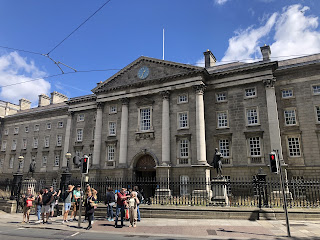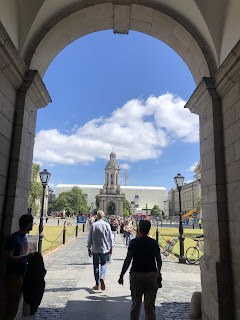Two days in Dublin
Charlotte and Arthur spent just two days in Dublin, less time than they had anticipated, as the cough that Charlotte had developed since her wedding day had been worsening. Nevertheless, the newlyweds enjoyed two days, sometimes in the company of Arthur’s brother Allen and his two cousins Joseph and Mary Anna.
Arthur wanted to show Charlotte his alma mater, Trinity College, Dublin. So we too went there to enjoy and see what they did. They (and we) walked through the grand archway.
They would have walked towards the Campanile which was new to Arthur too as it was built between 1852-4. Arthur graduated in 1844.
Charlotte and Arthur enjoyed a visit to the Old Library which dated from 1732. When they visited, it had a flat plaster ceiling and the bookshelves were on the lower level. Marble busts line what is known as the Long Room, these are of great philosopher's, writers of the western world and men associated with Trinity College Dublin. The bust collection started in 1743.
The Old Library as Charlotte and Arthur would have known it with the flat plastered roof.
The library’s roof was raised in 1860, six years after Charlotte’s visit. Today the room we see has a barrel-vaulted ceiling and the bookcases on the upper galleries. The main chamber of the Old library is almost 65 metres (213 feet) in length and is filled with 200,000 of the library’s oldest books. It is a grand sight!
Charlotte and Arthur would have been able to see The Book of Kells too, a 9th century illuminated manuscript of the four gospels of the Christian New Testament. We enjoyed the exhibition as well 168 years later!
The museum would have been available for our newlyweds to enjoy. Again, this would have been new to Arthur as it was built between 1853-57.
In a letter to Margaret Wooler dated 10 July 1854, Charlotte tells her,
“We spent two days in Dublin - drove over great part of the city - saw the College library, Museum, chapel &c…”
Here is the museum inspired by the Byzantine architecture of Venice. The interior is also stunning with a range of Irish marbles and Cornish serpentine, with the domed roof constructed of red, yellow sand blue enamelled bricks. It certainly is a distinctive building on the Trinity College campus.




Charlotte and Arthur spent the rest of their time in Dublin driving “over a great part of the city”, probably availing themselves of an outside Jaunting car, peculiar to Ireland.
What they saw we cannot know for certain but ‘The Tourist’s Illustrated Handbook for Ireland of 1854’ praises the virtues of Ireland’s capital city. Sights of note were the General Post Office and Nelson’s Pillar in Sackville Street (now O’Connell Street).
The General Post Office.

They may have seen the Four Courts at the Quays.
Dublin Castle, City Hall, Christ Church Cathedral may well have been seen on their tour.
City Hall Dublin
Christ Church Cathedral Dublin.
If they needed fresh air and nature they could have visited the Phoenix Park and the National Botanic Gardens.
We have no way of knowing precisely what they saw but these were the main sights in Dublin.
Arthur, knowing how much Charlotte and her father admired the Duke of Wellington, may well have ensured that their Jaunting car passed by Mornington House, 24, Upper Merrion Street, Dublin (now the Merrion Hotel) where Arthur Wellesley, the Duke of Wellington was reportedly born in 1769. Maybe they saw the work in progress of the 62 metre (203 feet) high obelisk which commemorates him in Phoenix Park. This was built between 1817 to 1861.
24, Upper Merrion Street, Dublin part of the now Merrion Hotel.
With Charlotte's cough and cold not getting any better, coupled with what she later described in a letter to Margaret Wooler dated 10th July, 1854 written from Banagher, as "fatigue and excitement" which had "nearly knocked me up" the Dublin stay was cut short.
Accompanied by Allen, Arthur's brother, and his two cousins Joseph and Mary Anna, the newlyweds decided to head to Arthur's family home in Banagher - in the midlands of Ireland.
The question is - how did they get there? This we do not know for sure, but I shall explore the possibilities in the next post.



























Comments